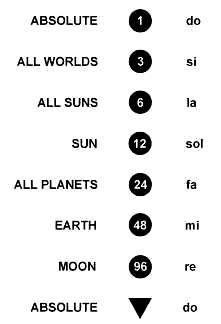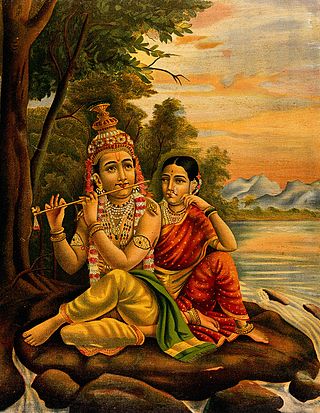According to Sri Aurobindo
Introduction
| Sri Aurobindo |
|---|
 |
For Sri Aurobindo, involution is the process by which the Omnipresent Reality, i.e. the Absolute, Brahman extends Itself to create a universe of separate forms from out of Its own Force/Energy.
Sat , Chit-Tapas , and Delight/ Ananda are the three aspects of Satchitananda , and they are part of involution. Spirit or consciousness manifests as these three, and then as the intermediate link of Supermind, which is transitional between the higher and lower (matter, life, and mind) nature. [2]
The reason for involution is Delight—the Delight of Being (the Spirit or Absolute) moving to Delight of Becoming (temporal existence, the cosmos). Being throws itself forward into a multiplicity of forms, becoming lost in the inconscience of matter, [3] and then through evolution it partakes in the Delight of rediscovering the Spirit which had been hidden in the interim.
Evolution is thus the movement forward by which the created universe evolves from its initial state of inconscience (i.e. as matter), evolves animated life forms and mental beings (i.e. humans), and continues to evolve spiritual properties, and in that process rediscovers its Source. Such an Evolution of animated forms is only possible because at each stage of development, the developing entity contains within itself the conception of what it may become. Thus, the evolution of animated life out of matter supposes a previous involution of that animated capacity. This is akin to a seed that already has the essence of the tree that will emerge from it.
Each plane emerges from an earlier plane through the evolutionary process, which takes place in chronological time. But in a parallel construction, each of these new planes can be understood as being a descendant of its corresponding higher order plane from the Infinite. Thus, when mentality emerged in the universe, the universal plane of Mind was implanted to a degree in those beings harboring that mentality.
The evolution is the development of all entities in the cosmos, including humans, in order to attain their fulfillment, including the discovery of spiritual Delight, which was, and always is, the experience of the Source Creator. The evolution is the progressive development from the original inconscience of matter into life (movement, sensation, desire, etc. and living physical beings), and from thence to mind (in conscious animals and most especially humans—the self-conscious thinking animal), and from thence to spiritualized mind, culminating in The Supermind or Truth Consciousness (as supramental individuals, and finally the supramental, i.e. a divine life on earth). [4]
Sat
We cannot speak of Sat without Chit and Ananda—-or Being, Consciousness and Bliss, respectively. They represent a totality. Sat is the vital state of that which is, was and always will be. In a sense it is a beginnining but because it is pregnant with possibility it is inexorably tied to Ananda or the recognition of Being and then the subsequent realization of bliss which is divine inner knowing. Each flows out of the other and then back again. It could be said that Sat only exists through Ananda or Consciousness however, these levels of differentiation cannot grasp the true nature of either of these three qualities since they are interdependent.
"Sat—being, existence; substance; "pure existence, eternal, infinite, indefinable, not affected by the succession of Time, not involved in the extension of Space, beyond form, quantity, quality", the first term of saccidananda and the principle that is the basis of satyaloka; "the spiritual substance of being" which is cast "into all manner of forms and movements"; existence as "the stuff of its own becoming", which on every plane is "shaped into the substance with which Force has to deal" and "has formed itself here, fundamentally, as Matter; it has been objectivised, made sensible and concrete to its own self-experiencing conscious-force in the form of self-dividing material substance" short for sat brahman." [5]
Chit-tapas
Chit-Tapas or Consciousness-Force, in Sri Aurobindo's philosophy refers to the pure energy of Consciousness by which creation ultimately comes about; the infinite divine self-awareness which is also the infinite all-effective Will. It is also one of the seven planes of existence, according to the Vedic cosmology and the seven lokas of Hindu thought.
In chapter 10 of The Life Divine , Sri Aurobindo writes at length on the nature of Consciousness-Force as a principle of the Divine. As he understands it (following the Tantric dichotomy of Shiva and Shakti), Chit or Consciousness is not an inert and passive principle; but contains the potential spiritual Energy, Tapas_(Indian_religions) , which in Creation becomes the dynamic and creative principle or Force, called Shakti . Chit-Tapas or Chit-Shakti is therefore the universal Consciousness-Force, the divine Energy; the Mother.
Delight
Delight is Sri Aurobindo's term for ananda, and plays a large part in his cosmology and spiritual teaching. Delight is the reason for creation, by which The Absolute extends its Delight of Being into multiplicity, losing itself in the unconscious and then through Delight rediscovering Itself through individuals realising their Divine nature and proceeding to spiritual realisation.
In other words, the universe was created so that the Delight of the Infinite Spirit can manifest in all the forms of creation. When we discover our higher nature, the soul and spirit, we experience the delight for which we were came into being and of which we are a part.
In chapters 11 and 12 of The Life Divine , Sri Aurobindo writes at length on the nature of Delight as a principle of the Divine, and its role in creation.






